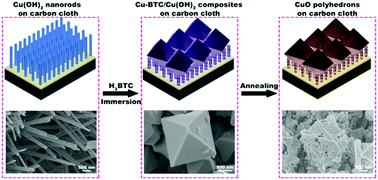In situ formation of metal–organic framework derived CuO polyhedrons on carbon cloth for highly sensitive non-enzymatic glucose sensing†
Abstract
Metal–organic frameworks (MOFs) are considered promising templates for the fabrication of nanostructured materials with high porosities and high surface areas, which are important parameters for enhanced performance in sensing applications. Here, a facile in situ synthetic strategy to construct MOF-derived porous CuO polyhedrons on carbon cloth (CC) is reported. Uniform Cu(OH)2 nanorods are first synthesized on carbon cloth, followed by the conversion of Cu(OH)2 nanorods into porous CuO polyhedrons via a copper-based MOF, Cu–BTC, as the intermediate species. When evaluated as a glucose sensing electrode, the as-fabricated CuO polyhedrons/CC composite exhibits a high sensitivity of 13 575 μA mM−1 cm−2 with a fast response time (t90) of 2.3 s and a low detection limit of 0.46 μM. This work exemplifies the rational fabrication of porous nanostructures on conductive substrates for enhanced performance in glucose detection.



 Please wait while we load your content...
Please wait while we load your content...
